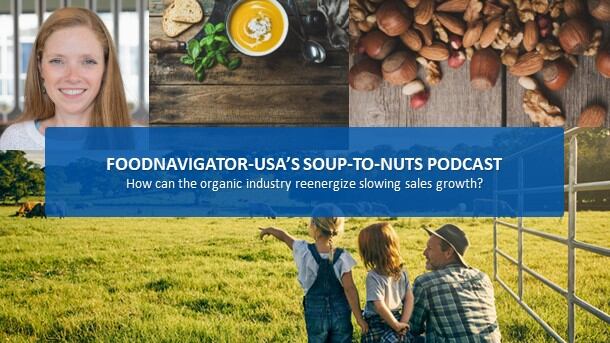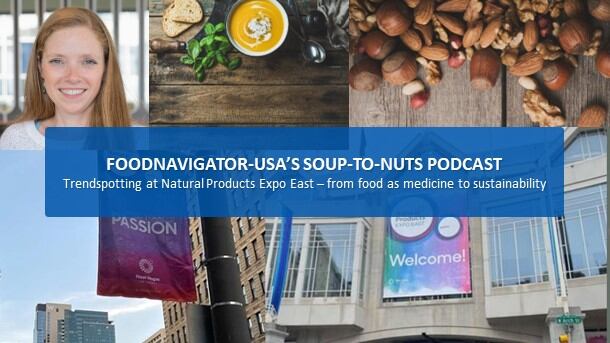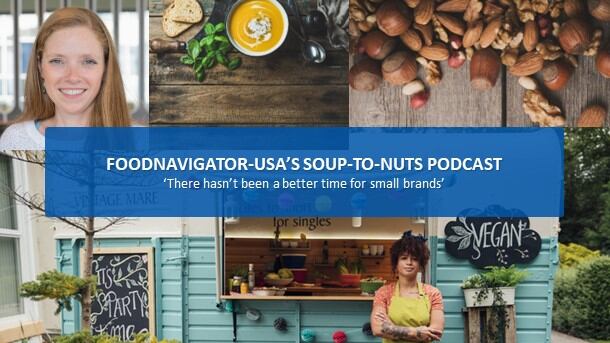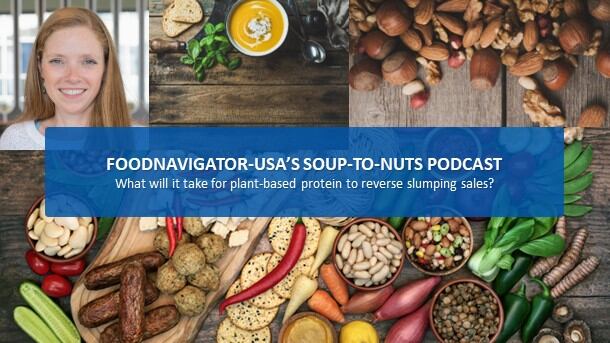According to the Organic Trade Association’s 2022 Organic Industry Survey released this summer, organic sales between 2020 and 2021 surpassed $63 billion with food sales reaching $57.5 billion. While strong, these figures are only about 2% above those of the previous year, which saw much more dramatic growth in the range of about 13%, thanks in large part to pandemic pantry loading that brought many first time consumers to the space.
OTA attributes this slowdown in part to consumers returning to “more stable, buy-as-you-need shopping patterns,” but the trade group’s CEO and executive director Tom Chapman also acknowledges external challenges, including supply shortages, higher prices due to inflation, increased competition from other value propositions, such as regenerative, and a lack of consumer awareness about organic’s full value proposition.
But, as he explains in this episode of FoodNavigator-USA’s Soup-To-Nuts podcast, many of these headwinds are ‘short-term’ challenges that OTA is aggressively addressing, and longer-range trends show organic still has significant growth potential, which the trade group is working closely with stakeholders and the government to seize.
[Editor’s Note: Never miss an episode of FoodNavigator-USA’s Soup-To-Nuts podcast – subscribe today.]
'Organic saw tremendous growth during COVID'
At Natural Products Expo East in Philadelphia earlier this month, Chapman explains he is very ‘bullish’ about organic’s long-term potential despite a slowdown in growth, in part because many of the reasons why consumers’ flocked to space during the pandemic continue to gain momentum – especially the idea of food as medicine and the desire to improve the welfare of workers, and by extension farmers.
“Organic saw tremendous growth during COVID – that can’t be denied. Consumers really started to focus on the benefit, the way food can be seen as medicine and really turned a corner in an area that we saw a lot of interested in already,” Chapman said.
But, he added, this spike in demand placed pressure on the supply chain and pushed prices up and it is difficult to know the extent to which these, and other factors, hindered sustained and growing sales.
Even as prices rise and consumers look for ways to stretch their budgets, Chapman said he is encouraged that most people aren’t trading away from organic, but rather to private label or less expensive organic options. However, he noted, he is concerned about the aspirational organic shopper who may have an even tighter budget, and worries they may not stay in the segment as the economy constricts.
To keep them engaged, Chapman said that the industry needs to talk about the value proposition of organic, including health benefits and climate solutions – two big points that he adds make him “really bullish for organic” despite current headwinds.
Tackling supply shortages: USDA’s Organic Transition Initiative
Like many segments of the food industry, organic products across categories have suffered supply shortages on and off since the beginning of the pandemic – part of this is due to adverse weather delaying or limiting the planting and harvests of some crops, some is due to farmers choosing to plant more of the organic crops that were more profitable last year and less of other crops, some is due to shortages of other components like packaging, labor and transportation and part of it is due to demand outstripping availability.
Chapman explains that while this last point isn’t new, it is by far the most stubborn and one that OTA is working closely with the US Department of Agriculture to address, including with a recently announced $300 million investment that pulls funds from the American Rescue Plan to help encourage and ease organic transition.
“We’re extremely excited about the Organic Transitions Initiative and that $300 million is the largest single funding for organic programming coming from USDA and using this as a tool to really bolster domestic supply, bring these benefits down to the farmer level and make sure that they’re well supported in their pathway to organic,” he said.
The Organic Transition Initiative plans to do this by offering direct farmer assistance in the form of increased organic expertise throughout its regions and adding organic experts to its regional technology support centers and also by covering a portion of their insurance premiums. The initiative also intends to support additional processing and distribution capacity, which is currently in short supply and holding back production.
Tackling inflation: Balancing farmers’ and consumers’ diverging pricing needs
Increasing supply to meet demand could create additional self-defeating challenges, including driving down price premiums for organic, on which farmers rely because their yields tend to be lower and expenses higher.
At the same time, the higher prices organic currently commands are taking a toll on the industry’s growth by limiting access for consumers who increasingly are feeling squeezed by inflation and beginning to trade down to less expensive options to stretch their budgets.
Chapman acknowledges that balancing both of these needs will be a challenge, but he says it can be done by looking for cost management opportunities between the farmer and consumer and strategically leveraging government procurement.
“This is an ongoing challenge that organic is going to have to figure out – there is no one solution,” Chapman said, noting that OTA is open to ideas from the industry even as it pursues legislative and regulatory options, such as removing barriers to organic for government procurement for school meals, the Women Infant and Children program and other benefits.
Hand-in-hand with increasing consumer access to organic is increasing diversity within the organic industry across the value chain, a transition which Chapman argues could further expand the shopper base by bringing to market more organic products that are culturally relevant and price sensitive.
At Expo East, the Organic Trade Association unveiled a new tool in the form of the Organic Diversity Resource Library, which Chapman explains includes a collection of diverse experts, providers and others that industry players can access.
“That is just one phase of it, though. There’s so much more to do. We also are sponsoring members and businesses who are organic or trying to convert to organic to come in underneath the trad association, work with our experts in the trade association, as well as members to mentor them to provide them the tools that they need,” he said.
In addition, OTA is making the application process more accessible by offering tools in multiple languages and better defining terminology that may not be familiar to entrepreneurs looking to enter organic for the first time.
Leveling the competitive playing field with consumer education
The slowdown in organic’s growth can also be attributed in part to the rise of competing value-based claims and certifications – most prominently regenerative, which appeals to consumers’ rising interest in sustainability, but which Chapman says often don’t go as far as Organic.
He explained that regenerative is a ‘very complex topic,’ and that while it shares many common attributes with organic, it may not share them all. Organic has stricter standards in some aspects and, depending on the regenerative certifier, regenerative may include aspects that organic does not, such as worker welfare and social obligations.
While Chapman says he has no problem with layering additional attributes on top of organic, he worries about consumer confusion and that some valuable components of organic may get lost in the shuffle.
One way OTA is addressing this challenge is through a consumer education campaign that pulls a page from its playbook for managing the competitive threat from non-GMO movement, which Chapman explained similarly threatened dilute the power of organic by playing up one component.
So, like the OTA’s “organic is non-GMO” campaign from a years ago, the trade group has created a toolkit to promote “organic is regenerative.”
In addition, this fall, OTA will develop a toolkit and conversation to educate retailers about the sustainability story of organic, which goes beyond the stringent guidelines for pesticides and chemicals for which it currently is best known.
At the same time, Chapman said, OTA and other stakeholders will step up their efforts to ensure that organic meets consumers’ expectations by working the government to continuously improve the standards.
This has been a source of frustration for some in the industry who are angered that updates to organic pushed forward by the industry have not been officially incorporated into the paradigm by their partners at USDA.
Still, Chapman is optimistic, noting the collaboration with the US government recently has begun moving forward the organic standards, such as the recent adoption of the origin of livestock rule.
If balancing all of these priorities sounds like a tall order, that is because it is, says Chapman, who added that in order to succeed stakeholders from across the organic industry must work together to reinforce organic’s value proposition, recognize the contributions everyone makes in their own space and offer a helping hand, where possible, in other areas for the common good.
Those who are interested in learning more about the evolution of the organic space can visit ota.com and those who want to know more about parsing and supporting sustainability claims, the circular economy and the growing food as medicine movement can do so by registering for FoodNavigator-USA’s upcoming digital summit Nov. 15-17, during which we will take a deep dive into these issues and more. Check out the agenda and register at foodnavigatorsummit.com





